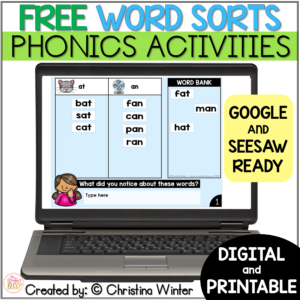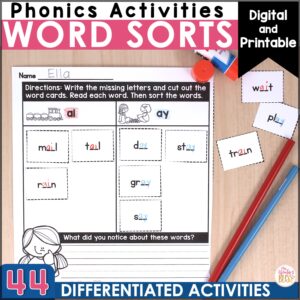Automatic pattern knowledge is critical to spelling and understanding how words work. Sorting words is an opportunity to examine words, search for common patterns, and categorize discoveries. Word sorting can be crafted into a critical thinking exercise. Sorts should encourage learners to compare and contrast words, link knowledge, reflect about their discoveries, explain their thinking, and refine their knowledge.
To support analysis of words, word sort activities need to balance phonemic awareness with visual patterns. Children need to connect phonemes to visual patterns and visual patterns to phonemes. Digging deep into my reserves of word work activities, I realize written blind word sorts support this type of association.
Written Blind Word Sorts
What is a written blind word sort? Begin by thinking about a blind word sort. This is when words are sorted but not seen. Add writing and you have a written blind word sort. Written blind word sorts arouse the mind, stimulating visualization of spelling patterns with associated phonemes.
Of course students are not completely blind to visual spelling patterns during this activity. Key words are used to support visual and phonemic analysis. What is a key word? A key word is one that exemplifies a specific spelling feature. Key words are often used to introduce and anchor understanding of specific spelling features. Vowels, syllable doubling, affixes, and derivatives are a few spelling features students need help sorting out. I like my key words to hang out on my word wall. Click here to download some of my favorite words for blind sorts.
Begin your sort by presenting each key word. Chalkboards, overhead projectors, word cards, or Smartboards all work for showing key words. Chorally read the key words. While working with young English language learners, I have developed a habit of reading words three to five times. Remember, you are trying to balance phonemic analysis with visual analysis. Prompt your students to neatly copy the key words at the top of a page. Word study notebooks, a word sort worksheet, a wipe-off board, or paper will also work. While students copy key words, I encourage them to think and say each word as an aid to noticing spelling patterns. Briefly discuss the spelling feature. I encourage children to highlight or underline the feature. Verbalizing and then highlighting helps children see, hear, and then apply a pattern while sorting.
Students work with a partner or in a small group. Grouping allows you to differentiate instruction, matching student confusions with an appropriate sort. The teacher or a selected student reads a list. I build my lists with straightforward words first and then challenging words. Children record dictated words neatly under key words. I ask students to underline spelling patterns while writing their dictated list. The pair examines the sort. My goal is for thoughtful discussion and reflection. To ensure this, I teach kids to use a few prompts when they notice a mistake.
Do all the words look right?
Are there any words you want to move? Why?
Look at _____; now say _____. Does it fit the pattern?
Look at _____. Does it look right? Where doesn’t it look right?
Can you fix it?
Once the words are sorted to the best of the children’s understanding, I ask them to reflect, writing a statement that explains how the words were sorted.
Students bring their finished sorts to me. I ask them to orally explain what they did, what they learned, and how it will help their spelling. Early in the school year this last part is a struggle. To help students understand this valuable prompt, I ask them to add a word or two to their list that is challenging. This is a first step toward applying a focus of learning.
My children have learned that using blind word sorts during spelling cycles has helped them learn how to match visual patterns to phonemes. During this exercise students actively engage in a process similar to one they use while writing unfamiliar words.
Written Blind Word Sort in a Nutshell
- Present key words.
- Notice and discuss spelling features of key words.
- Copy key words and highlight spelling features.
- Dictate and write words under key words.
- Review and revise sort if necessary.
- Reflect.
- Check in with the teacher.
Sorting is a critical thinking skill. Try using writing blind word sorts to extend students’ spelling knowledge.
Back to top
1a : to put in a certain place or rank according to kind, class, or nature sort apples sort mail. b : to arrange according to characteristics : classify —usually used with out sort out colors. 2 chiefly Scotland : to put to rights : put in order. 3a : to examine in order to clarify —used with out sorting out his
Contents
- 1 What is sort word?
- 2 What does sort mean in writing?
- 3 What does a sort mean in England?
- 4 What is the example of sort?
- 5 How do you use the sort?
- 6 What does a right sort mean?
- 7 Where does the word sort come from?
- 8 Why is sorting important?
- 9 What does sort of speak mean?
- 10 What does mean nothing of sort?
- 11 What is the difference between kind of and sort of?
- 12 How do I sort files in Linux?
- 13 What is a blind sort?
- 14 What is a sort in technology?
- 15 What is a blind writing sort?
- 16 Has been sort meaning?
- 17 What is a sort Cockney?
- 18 What does it mean when someone calls you salt?
- 19 What does sorting mean in medical terms?
- 20 What are the types of sorting?
Word’s sorting tool allows you to sort text a number of different ways in your document. You can sort tables, dates, paragraphs, and more with just a few clicks in Word.
What does sort mean in writing?
verb. (tr) to arrange according to class, type, etc. (tr) to put (something) into working order.
What does a sort mean in England?
English Language Learners Definition of sort
(Entry 1 of 2) : a group of people or things that have some shared quality : a particular kind or type of person or thing.
What is the example of sort?
To sort is to put things in order or group them into categories. When you put all your white clothes together and all your dark clothes together, this is an example of a situation where you sort your clothes.
How do you use the sort?
Definition of of the sort
: like the person or thing mentioned “You said you didn’t like him.” “I said nothing of the sort.” I would like to go to a movie or a concert, or something of the sort.
What does a right sort mean?
If something such as a choice, action, or decision is the right one, it is the best or most suitable one. rightly adverb [ADVERB with verb]
Where does the word sort come from?
sort (n.) late 14c., “group of people, animals, etc.; kind or variety of person or animal,” from Old French sorte “class, kind,” from Latin sortem (nominative sors) “lot; fate, destiny; share, portion; rank, category; sex, class, oracular response, prophecy,” from PIE root *ser- (2) “to line up.”
Why is sorting important?
Answer: Sorting is important in programming for the same reason it is important in everyday life. It is easier and faster to locate items in a sorted list than unsorted. Sorting algorithms can be used in a program to sort an array for later searching or writing out to an ordered file or report.
What does sort of speak mean?
When you use an expression that is not meant entirely literally, or is slang or informal, you may follow it with “so to speak” or “in a manner of speaking.” It is most appropriately used to acknowledge that you have just expressed an idea in an unusual fashion.
What does mean nothing of sort?
Definition of nothing of the sort
: nothing like that —used to object to something or to deny something “I’m quitting school.” “You’ll do nothing of the sort!””You said you would give me a loan.” “I said nothing of the sort”.
What is the difference between kind of and sort of?
Kind of is more common in American English. Sort of is more common in British English: He’s kind of jealous that they have become such good friends. I’m sorry but she’s just kind of lost interest in buying the car.
How do I sort files in Linux?
How to Sort Files in Linux using Sort Command
- Perform Numeric Sort using -n option.
- Sort Human Readable Numbers using -h option.
- Sort Months of an Year using -M option.
- Check if Content is Already Sorted using -c option.
- Reverse the Output and Check for Uniqueness using -r and -u options.
What is a blind sort?
Blind Sort/No-Peeking Sort (same thing) – Students work with a partner.The partner picks up a word card and reads the word (or names the picture) without showing it to the student. The student listens to the sounds in the word and points to the category in which the word belongs.
What is a sort in technology?
Sort is a term used to describe the process of organizing data in a particular order allowing for information to be found easier.For example, names and contact information may be sorted in alphabetical order to allow the person looking for a name to see if it’s available.
What is a blind writing sort?
What is a written blind word sort? Begin by thinking about a blind word sort. This is when words are sorted but not seen. Add writing and you have a written blind word sort. Written blind word sorts arouse the mind, stimulating visualization of spelling patterns with associated phonemes.
Has been sort meaning?
used to describe a situation in which everything is correctly organized or repaired, or when someone has everything that is needed: Debbie’s sorted for Tuesday night because she’s found a babysitter. “Have you spoken to Grant about the party?” “Sorted!” Linguistics: interjections. aiyo.
What is a sort Cockney?
Sorted is Cockney slang for Satisfied, content.
What does it mean when someone calls you salt?
Many people use this word when describing somebody’s emotional condition.The Oxford English Dictionary lists that the slang word salty means: angry, irritated or hostile. To undergo a sudden change of mood or outlook and to become annoyed or angry with someone are two meanings also found in the OED.
What does sorting mean in medical terms?
Triage: The process of sorting people based on their need for immediate medical treatment as compared to their chance of benefiting from such care.
What are the types of sorting?
Sorting Algorithms :
- Selection Sort.
- Bubble Sort.
- Recursive Bubble Sort.
- Insertion Sort.
- Recursive Insertion Sort.
- Merge Sort.
- Iterative Merge Sort.
- Quick Sort.
A word sort is a developmental word study activity espoused by the Words Their Way curriculum as written by Donald R. Bear, Marcia Invernizzi, Shane Templeton, and Francine Johnston. The activity focuses students’ attention on critical features of words, namely sound, pattern, and meaning.[1]
Recent descriptions of comprehensive vocabulary programs identify fostering word consciousness (getting students really interested in and excited about words) as a crucial component of effective programs.[2] Word sorts are a method to foster word consciousness.
Role of Word SortsEdit
The process of sorting words into various categories is the heart of word study. By categorizing different words by certain elements, young children make sense of words and patterns within words. Word sorts combine both constructivist learning and teacher-directed instruction.[1]
Students receive a stack of cards containing either pictures or words that have several types of contrasting sounds, patterns, or meanings. Each student must then figure out the patterns that exist within the stack, and sort the cards accordingly. By doing this, students construct their own knowledge of words, creating a lasting understanding of how language works. This process contrasts greatly to the simple memorization related to traditional spelling tests.
The more students understand about the structure of words — their spelling or orthography — the more efficient and fluent their reading will be. Word sorts place instructional emphasis on the exploration of patterns that can be detected in the sound, structure, and meaning features of words. Thus, word sorts contribute to orthographic or spelling knowledge, the engine that drives efficient reading as well as efficient writing.[3]
Types of SortsEdit
There are three different types of word sorts: sound sorts, picture sorts, and word sorts.
Sound SortsEdit
Sound sorts can take on many forms in a primary classroom and this is essential because sound is the first layer of English orthography.[1] Sound study can be introduced at a very early stage and develop with a child’s individual ability. Sorting pictures or oral vocabulary is a manipulation of sounds, and this manipulation increases awareness. A simple introductory sort is by initial sound and this can develop to ending sound, vowel sounds, and word families sorts. The root of importance is student motivation and involvement in the sort. By “setting the scene with sounds,»[4] sorts may include concrete materials and pictures linked to learner interest. Phonemic awareness, not phonics, is the understanding that our spoken sounds work together to make words. This is a very early understanding that can be developed in a variety of ways. Comparing sounds is the easiest task for developing phonemic awareness.[5] Sound sorts can be introduced very early on and develop strategically throughout primary learning.
An ability to sort sounds is essential for early reading because sound manipulation is a stepping stone to word study and decoding ability. For some students a direct instructional approach is not necessary in the development of sound study and sorting. Other children who have had less exposure or lack the understanding of sounds and their manipulability may need further instruction to develop their ability. Teachers have a responsibility to students they serve to identify their needs and implement instructional strategies to scaffold students’ understandings of sounds.
Intervention strategies may be necessary in remediating students who cannot correctly identify sounds in isolation on a given opportunity.[6] Programs like Reading Recovery have contemporary phonemic techniques embedded in the program. Also, books and poems may specifically focus on word families and similar sound patterns for children to identify and understand in context.[7] Sound sorts can be integrated through programs, or very inexpensively through teacher-created materials. For example, students can sort pictures by beginning sound, rhyme, or ending sound. Students do not need to have strong phonics skills in order to engage in sound sorts. This can be a beginning phonemic awareness activity because students need only to identify the sound in order to complete the sort. Letter knowledge is not required, and phonemic development can mature as students do acquire more print knowledge.
Picture SortsEdit
Picture sorts are one component of word study and are used to help beginning readers develop Concept of Word, phonological awareness, and phonics.[1][8] Picture sorts most often begin with focusing on initial sound (single consonant, digraphs, or blends). By using picture sorts teachers are able to help students who do not have extensive reading vocabularies focus on isolated sounds (Initial, final, or medial) within a spoken word.[1] These sorts are often a child’s first introduction to word study and are most commonly used with students whose developmental skills are at the emergent, letter name-alphabetic, or early within word Spelling Stages.[9]
Word SortsEdit
Word sort activities involve students comparing, contrasting, and classifying words — considering words from a variety of perspectives.[3] Bear et al. emphasized the importance of comparing those words that do fit into a particular category with those that don’t. This type of engagement with words will for most students lead to the abstraction of spelling patterns and the sounds to which they correspond.[1]
Word sorts can be teacher directed (closed) or student directed (open). For example, students in the with-in-word pattern phase of word knowledge could sort words according to a vowel pattern; in such sorts there is always a miscellaneous category for words that do not follow the target categories.[3]
| cat | make | car | miscellaneous |
|---|---|---|---|
| mad | race | star | fall |
| flat | game | hard | ball |
| cap | place | mark | x |
| grab | plate | park | x |
Game-like formats such as board games and card games can also be effective if they focus on words that reflect spelling patterns. Word-building activities also facilitate abstraction of pattern: word wheels, flip charts, making words. Spelling or word study notebooks may be used to record, collect, and organize information about words and spelling patterns learned from the word sort.[10]
Digital Word SortsEdit
To complement the many ‘hands on’ activities students use for sorting words, digitized word sorts provide an efficient way for teachers to deliver spelling pattern differentiation. A variety of these are ready-made, including Word Sorter.
Adjusting Word Sort Instruction for Students with Learning ProblemsEdit
Research has shown that students who experience significant difficulty with spelling follow the same developmental course as other students, but do so at a slower pace. In such cases, it is critical to provide word sort words at the appropriate developmental level, regardless of the students’ age and grade. Once the appropriate spelling instructional level is established — be it alphabetic, within-word pattern, or syllable juncture — instruction can be adapted by focusing on fewer words at a time, teaching spelling patterns in an explicit manner, and providing for copious amounts of practice and review.[11]
ReferencesEdit
- ^ a b c d e f Bear, D., Invernizzi, M., Templeton, S., Johnston, F. Words Their Way: Word Study For Phonics, Vocabulary, and Spelling Instruction. 4th ed. Upper Saddle River, NJ: Prentice Hall, 2008.
- ^ Graves, M.F., & Watts-Taffe, S. (2008, November). For the Love of Words: Fostering Word Consciousness in Young Readers. The Reading Teacher, 62(3), 185–193
- ^ a b c Templeton, S, & Morris, D (1999, January). Questions teachers ask about spelling. Reading Research Quarterly, 34(1), 102-112.
- ^ Moni, K. (2005). 20 Ways to Use Phonics Activities to Motivate Learners with Difficulties. Intervention in School and Clinic, 41(1) 42-5.
- ^ Holten, A. (2004). Children are best taught how to read by learning the sounds of letters. South Bend Tribune.
- ^ Joseph, L. (2002). Facilitating Word Recognition and Spelling Using Word Boxes and Word Sort Phonic Procedures. The School Psychology Review, 31(1), 122-9.
- ^ Glazer, S. (2005). To Phonic or Not to Phonic? Teaching Pre-K-8, 36(3), 71+.
- ^ Morris, D. (2005). The Howard Street tutoring manual: Teaching at-risk readers in the primary grades (2nd Ed). New York, NY: The Guilford Press.
- ^ Bear, D. R., Templeton, S. (1998). Explorations in developmental spelling: Foundations for learning and teaching phonics, spelling, and vocabulary. The Reading Teacher, 52(3), 222-243.
- ^ Cunningham, P. (1995). Phonics They Use. (2nd ed.) New York: HarperCollins.
- ^ Worthy, M.J. Invernizzi, M. (1990). Spelling errors of normal and disabled students on achievement levels one through four: Instructional implications. Annals of Dyslexia, 40, 138-151.
External linksEdit
- Reading A-Z
- International Reading Association Publications
Writing sorts are different than the traditional copying of spelling words however because they require students to write words into categories. By writing their word list into categories, students attend to the sounds or patterns of letters and think about how those words connect with their key words or headers.
What are the three types of word sorts?
There are three types of sorts that correspond to the three layers of English orthography: alphabet, pattern, and meaning. In an Alphabet sort, students compare and contrast words by sound.
What is word sort strategy?
Word Sorts are vocabulary strategies in which students categorize the new words. In a Closed Word Sort, the categories are provided; in an Open Word Sort, students sort the words into any categories that make sense to them, encouraging creativity and critical thinking.
How do I sort in alphabetical order in word?
Sort a list alphabetically in Word
- Select the list you want to sort.
- Go to Home > Sort.
- Set Sort by to Paragraphs and Text.
- Choose Ascending (A to Z) or Descending (Z to A).
- Select OK.
How do I sort in alphabetical order in Word?
What does sort mean in Word?
transitive verb. 1a : to put in a certain place or rank according to kind, class, or nature sort apples sort mail. b : to arrange according to characteristics : classify —usually used with out sort out colors.
What is an open word sort?
Word sorts are vocabulary strategies in which students categorize the new words. In a Closed Word Sort, the teacher provides the categories. In an Open Word Sort, students sort the words into any categories that make sense to them. They’re thinking creatively and critically.
What is alphabetical order with example?
The standard order of the modern ISO basic Latin alphabet is: A-B-C-D-E-F-G-H-I-J-K-L-M-N-O-P-Q-R-S-T-U-V-W-X-Y-Z. An example of straightforward alphabetical ordering follows: As; Aster; Astrolabe; Astronomy; Astrophysics; At; Ataman; Attack; Baa.
What are some ways to sort words?
Look for a button with the letters A and Z on it and an arrow pointing down. This is the Sort command. Click on the Sort button and Word will open the Sort Text window. On the Sort Text window, you’ll notice that there a number of options.
How can I sort by specific word?
Sort list by specific word (s) 1. Select a cell next to the list, type this formula =SUM (–ISNUMBER (SEARCH ( {“apple”,”banana”}, A1))), apple and… 2. Keep the formula cells selected, and click Data > Sort A to Z, and check Expand the selection in the Sort Warning… 3. Click Sort, then the list
Can you sort in word?
Select the text of your list.
How do you sort columns in Microsoft Word?
Highlight the rows and/or columns you want sorted. Navigate to “Data” along the top and select “Sort.”. If sorting by column, select the column you want to order your sheet by. If sorting by row, click “Options” and select “Sort left to right.”. Choose what you’d like sorted.

Here we are on Day 5 of Teaching Spelling through Word Study, a 10-day series I’m doing with iHomeschool Network. We’ve spent a lot of time on the background for word study, so if this is your first day joining me, I hope you’ll take a look back (click HERE or on the picture above to see a list of the posts thus far). Today’s focus is word sorts because they are at the heart of word study!
What are Word Sorts?
Let me start by showing instead of telling. Take for example this ai/ay word sort:
If you were my child and working on these patterns, I’d ask you to cut them apart and sort these words as either having the ai or ay pattern (a visual sort). Your sort would look something like this:
Then, we’d talk about the words and patterns: What do you notice about the long a spelling in the first column/in the second column? When was the ai pattern used? When was the ay pattern used? So what generalization or rule can you form from studying all these words? (Answer: When I hear the long a sound in the middle of the word, I use the ai pattern and when I hear the long a sound at the end of a word, I use the ay pattern.)
The Benefit of Word Sorts
Categorizing is the fundamental way that humans make sense of the world. When students sorts words they are engaged in the active process of searching, comparing, contrasting, and analyzing. Word sorts help students organize what they know about words and to form generalizations that they can then apply to new words they encounter in their reading.” (Words Their Way, 61)
1. Word Sorts are Hands-On
With word sorts, students learn by doing. Comparing, contrasting, manipulating, analyzing, formulating, creating; just a few words to describe what the student is doing while sorting the words.
2. Word Sorts Happen at the Child’s Instructional Level
We spent some time yesterday on how to find your child’s instructional level (also known as ZPD). This is where students learn best. Words for the word sorts are chosen to challenge, but not frustrate the child.
3. Word Sorts are Analytic in Nature
Many phonics programs are synthetic, like a puzzle. You give the child the puzzle pieces and ask him to put it together to form the entire picture. (Here are the letter sounds…now sound out these words.)
With word sorts, students are give the big picture (entire words) and asked to break them apart and analyze them, an important skill in reading and writing unknown words.
4. Word Sorts Don’t Rely on Rote Memorization
“Effective word sorts require more than copying the words from a list as seen in traditional spellers. [Copying] the word is not as important as the physical sorting.” (Mattmann and Cowan-founders of Spelling Scholar). Students are required to be active, not passive, participants in their own learning and understanding of how words work.
5. Word Sorts are Efficient
Each word sort contains many examples of that particular spelling pattern; more than a typical spelling worksheet. Word sorts (and the activities that accompany them) can also be done in a short amount of time. In our home, the word sorting activities take about 10 minutes maximum each day. And the same word cards can be used over and over for multiple purposes (more to come on this next week).
6. Word Sorts are Flexible
When I first taught in the classroom, all the kids had the same spelling list and everyone worked on the same phonics skill each week. I could clearly see that my spelling instruction worked for maybe 40% of my students, with it being WAY too easy for some kids and WAY too hard for other kids. This meant that at any given time, 60% of my class wasn’t truly learning! I was frustrated, but unsure what do about it. When I discovered the word study approach my second year of teaching, my spelling instruction was forever changed. While I’m now homeschooling, it is even more obvious that my children aren’t on the same spelling level. Word sorts (and picture sorts) help to differentiate that instruction, providing what each child needs.
{The 6 benefits listed above were adpated from Words Their Way.}
More Resources with Word Sorts:
- Helping Spellers Make Phonics Generalizations (from word sorts)
- My FREE Elementary Printables contains some seasonal word sorts
- 10 Days of Teaching Spelling Through Word Study
~Becky
Summary:
Word Sorts can be used within all content areas to increase vocabulary skills.
Procedure:
1. Determine what your word sort will focus on. What do you want your students to learn? It is important that the students are already familiar with the concept that they will be working with (e.g., number of syllables, long/short vowel sounds, parts of speech, etc). Some examples include:
- Words sorted by number of syllables: words with one syllable, words with two syllables, words with three syllables
- Words that contain long vowel sounds, short vowel sounds, or both long and short vowel sounds
- Words that contain consonant blends (and words that do not)
- Words from specific word families
- Words sorted into nouns, verbs, adjectives, and other parts of speech
- Words with one meaning and words with more than one meaning
- Compound words and words that are not compound words
- Student-determined — encourage them to determine which categories make the most sense!
- …the list could go on forever!
2. Decide which words will be used. The words could come from:
- classroom word wall
- individual word walls or word banks
- read aloud, shared reading, or guided reading texts
- poems read together in class
- children’s own writing
- math, science, or social studies texts
3. Determine what level of difficulty is appropriate. In general, the more categories there are, the more difficult the sort. For added challenge, you may want to include a category labeled “other” for words that do not fit in specific categories. This can be a good way to account for irregular words. For example, in a long A word sort, the word “says” would belong in an “other” category, because the vowel pronunciation is irregular.
4. Be sure that the students understand your expectations for both the process and the product of the word sorting activity. It is a good idea to model your expectations when you introduce it for the first time.
Examples:
http://www.readwritethink.org/classroom-resources/lesson-plans/sort-hunt-write-weekly-278.html
This is a Word Sort app that can be downloaded:
http://www.commonsensemedia.org/mobile-app-reviews/word-sort-by-grammaropolis
This is an example of students using the word sort strategy from the Department of Education.
http://www.vdoe.whro.org/elementary_reading/ConceptSorts1-20-2010_F8_FastStart_512k.swf
Reflect:
My students will build vocabulary by participating in word sorts. This activity could be done as a Warm Up activity from the previous days words. I will walk around the class and offer assistance if needed. I will collect the word sorts to grade and use as a formative assessment.
Citation:
Retrieved from Readstrong website http://myweb.stedwards.edu/mikekb/ReadStrong/wordsorts.html
Word Sort is a fantastic higher-order thinking activity that you can use to explore a text or topic. I first learned about Word Sort in the Teacher’s Guide for El Nuevo Houdini; I believe that the brilliant Kristy Placido came up with it. It’s used in one of the last three chapters, because we’ve not gotten there yet this year. Anyway, I loved it when we used it last spring, and I’ve been waiting for the opportunity to bust it out again!
Word Sort works best when you have a substantial text to work with–something that is chapter-length or longer. Short stories don’t usually have enough words in them to extract the value in this activity. Here’s how you do it:
Begin by pulling words from a text.
The words that you pull out of the text can be anything: names, places, adjectives, verbs, nouns…anything! Try to choose words that have some sort of significance to the text, as opposed to ambiguous words like “has” or “does” or “wants”: when used on their own, these words are not specific enough. You could also use short phrases, like “has friends”, “wants to leave”, or “isn’t happy”. Use any word or concise combination of words that carries meaning in the text. See an example of the Word Sort that I created for Chapter 5 of Esperanza here.
Format the words in a table
Next, enter the words into a table on a word document–three or four words across and eight to ten words down. You can fit 24-40 words on a page, depending on how big you want the text to be. For the activity to work well, I recommend using at least 48 words (2 sheets of 24 words, if that is how you formatted it). More is great! You can see an example that I used in Chapter 5 of Esperanza.
Group your students
Divide your students into groups of two to three students (four if you must, but I always think four is pushing it, with middle schoolers anyway!), and give each group a copy of the word tables. If the text is one that you will use again in future years, I recommend creating a reusable set and pre-cutting the words so that you maximize time spent interacting with the language (words) and minimize the set-up (cutting) time.
Assign the sorting task
Explain to the students that they must split up the words into categories. They must create their own categories for the words, but they may not create categories like “words” or “other”. They must fit every word into a category, and no category should have fewer than three words. (Try to include several words that don’t fit in well with anything else to make the activity more challenging!) They could keep it simple and do “people”, “places”, “things”, “adjectives”, etc., or they could try to be a bit more creative: create one category for each person or event, and put everything that has to do with that person or event in that category. Depending on which text you use, students can come up with some pretty awesome categories!!
Discuss students’ thinking
As they work, walk around the room and ask students to explain to you (in the target language) what their categories are and why the words in it fit into that category. You will find that they come up with some pretty far-fetched and creative explanations to fit certain words together!If a group finishes early, have them create new categories and re-organize the words.
My students love to do this with a text, and it is a great critical thinking activity. Try it, you’ll like it!!
Posts navigation
Previous article
Next article
Word sorts are an engaging phonics activity for K-2 students who are learning how words work while developing word awareness skills. Make sure to download a FREE sample of these differentiated word sorts in this post.
When we first introduce a new phonics skill it is best to keep the instruction explicit, clear, and to the point. But as I discussed in my last blog post, in order for students to truly master the phonics skills we teach we must provide them with lots of opportunities for review and repetition!
Even when we know we need to provide this extra practice, it can be a real challenge to keep coming up with activities that are engaging and effective. In his book Phonics from A to Z, Wiley Blevins encourages us to have our students explore and play with letter sounds and suggests word sorts are a great way to do so!
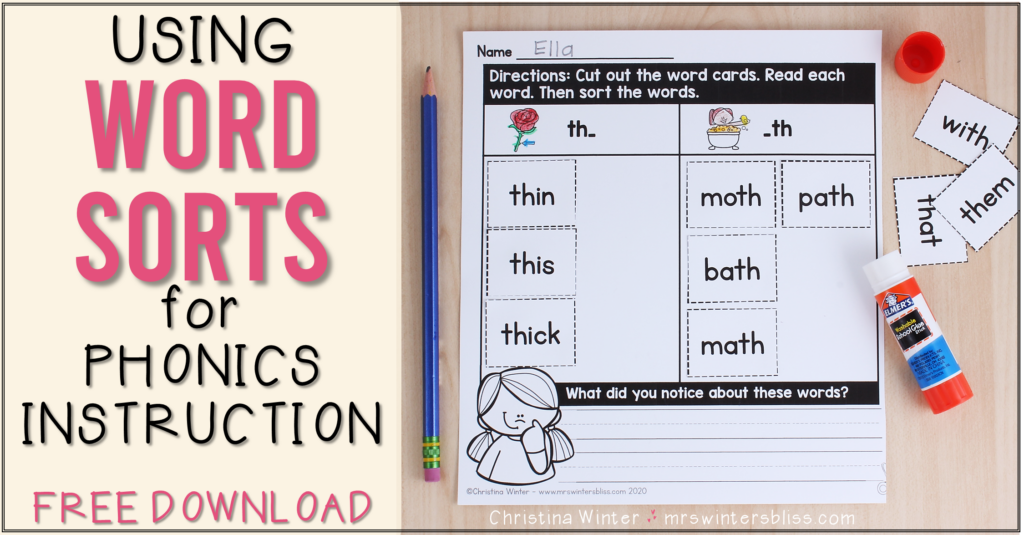
What are Word Sorts?
Word sorts require students to think about how words work by drawing their attention to common spelling patterns. Students are given a set of words that all have something in common and asked to sort them by the common feature.
There are many types of word sorts but the three most common are:
Open sorts: In an open sort, students are not told how to sort the words. They can sort them anyway they want. It is smart to start with an open sort because it gives you insight into students’ thinking and what they notice about words.
Closed sorts: In a closed sort, students are told how to sort words. Students visually scan the words for the pattern that you specified. The most valuable part of a closed sort is the conversation you have after the sort is complete. Blevins suggests questions like, What do you notice about these words? What do you notice about these spellings for long-o? Do you know other words with these spellings?
Timed sorts: In a timed sort, students are told how to sort a set of words but given a set amount of time to do so. A timed sort is a great thing to do with a set of words that students have been working with for a while. Students love the timed aspect which makes it feel like a game, but it also helps to train their eyes to quickly see larger word chunks which will help them when they encounter new and unfamiliar words.
Word Sort Routines
The routine for word sorts is simple! First, introduce the task by naming it and explaining the purpose.
Next, have students sort the words. If you’re doing a closed sort you’ll want to model one or two of the words. As students work, you can observe and ask students why they are putting specific words into each category.
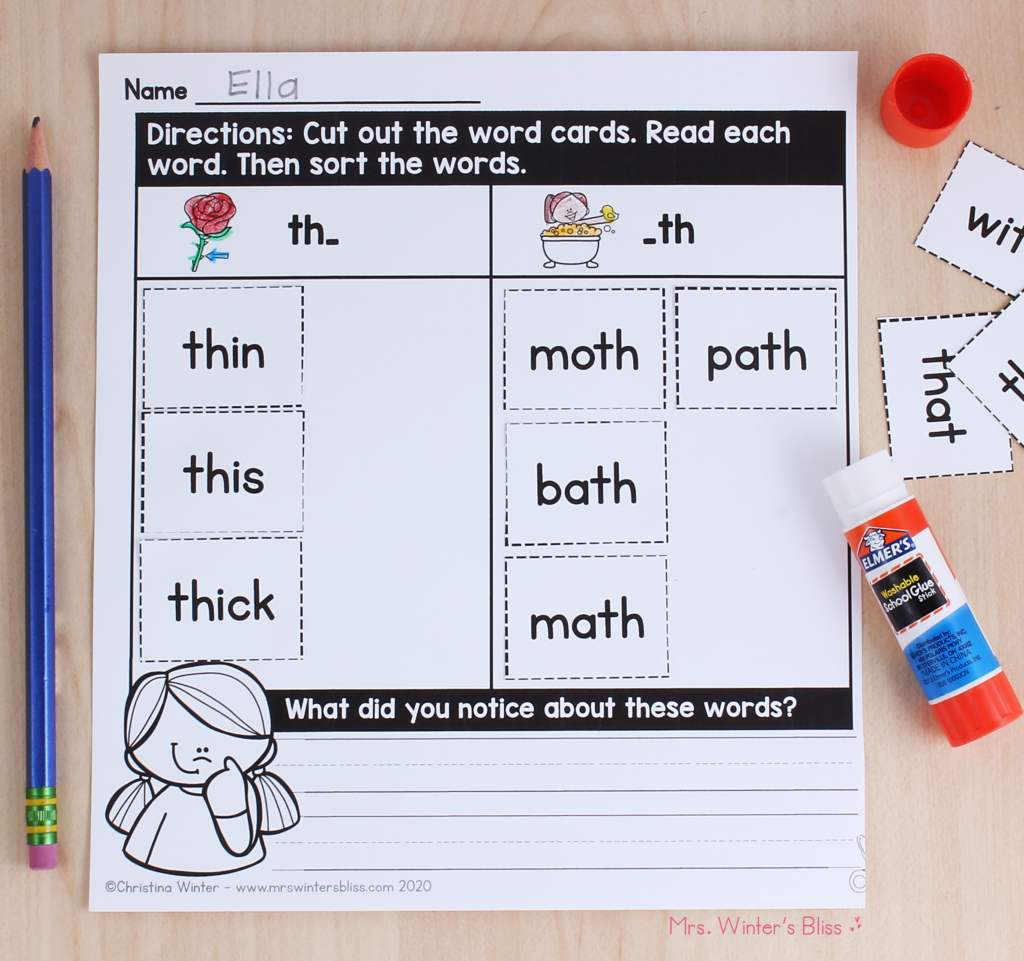
Finally, (and this is the most important one!) you’ll want to check and discuss the sort. Ask students what they learned about the words from doing the sort and guide them to the aspect that will help them in their future reading and writing!
Differentiated Word Sorts
Today I’m thrilled to share with you my very own Phonics Word Sort resource! These DIFFERENTIATED activities are both printable and digital so you can use them in the classroom or for distance learning with Google Classroom & Seesaw!
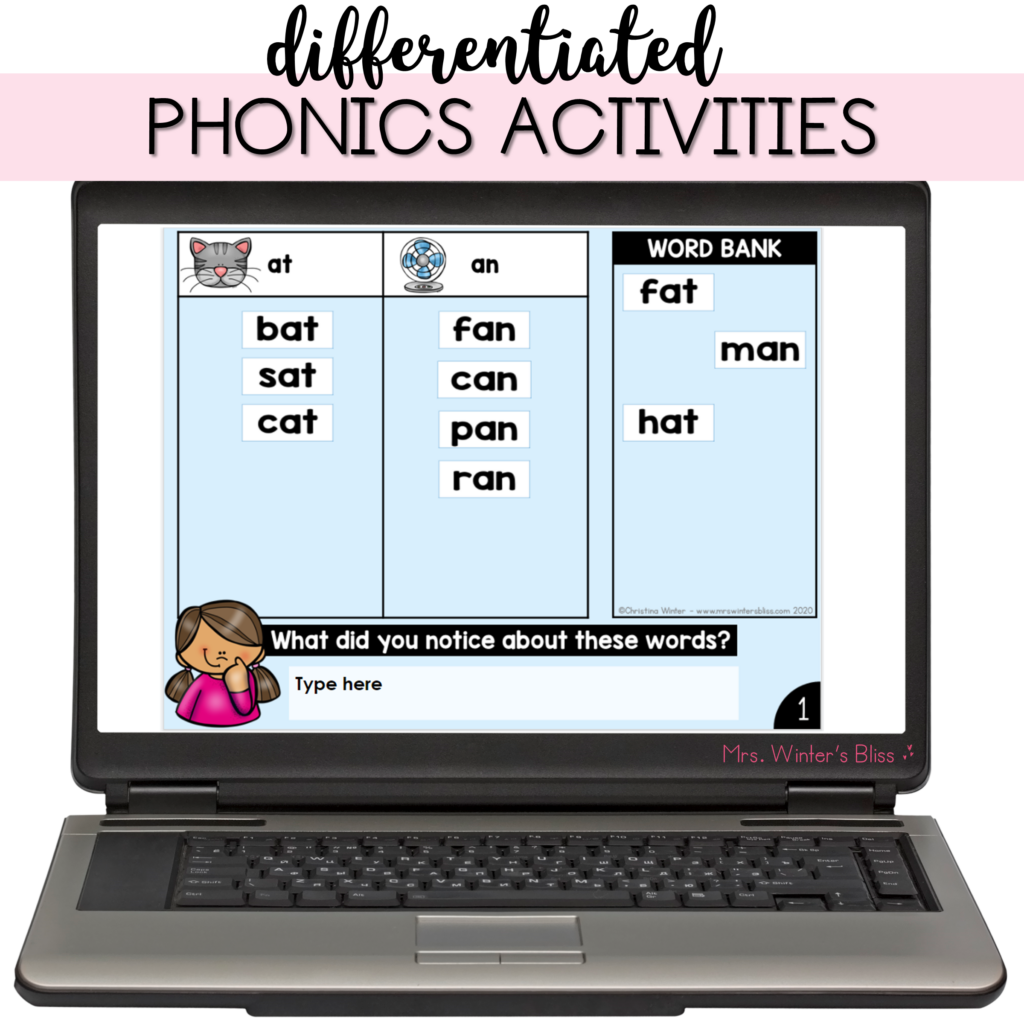
These word sorts are an engaging phonics activity to compliment your word study routines. There are two levels of word sorts: whole words and words with the missing target spelling pattern to assign to your students. Students will look for common spelling patterns, sort, then communicate what they notice and have learned about the words they’ve sorted.
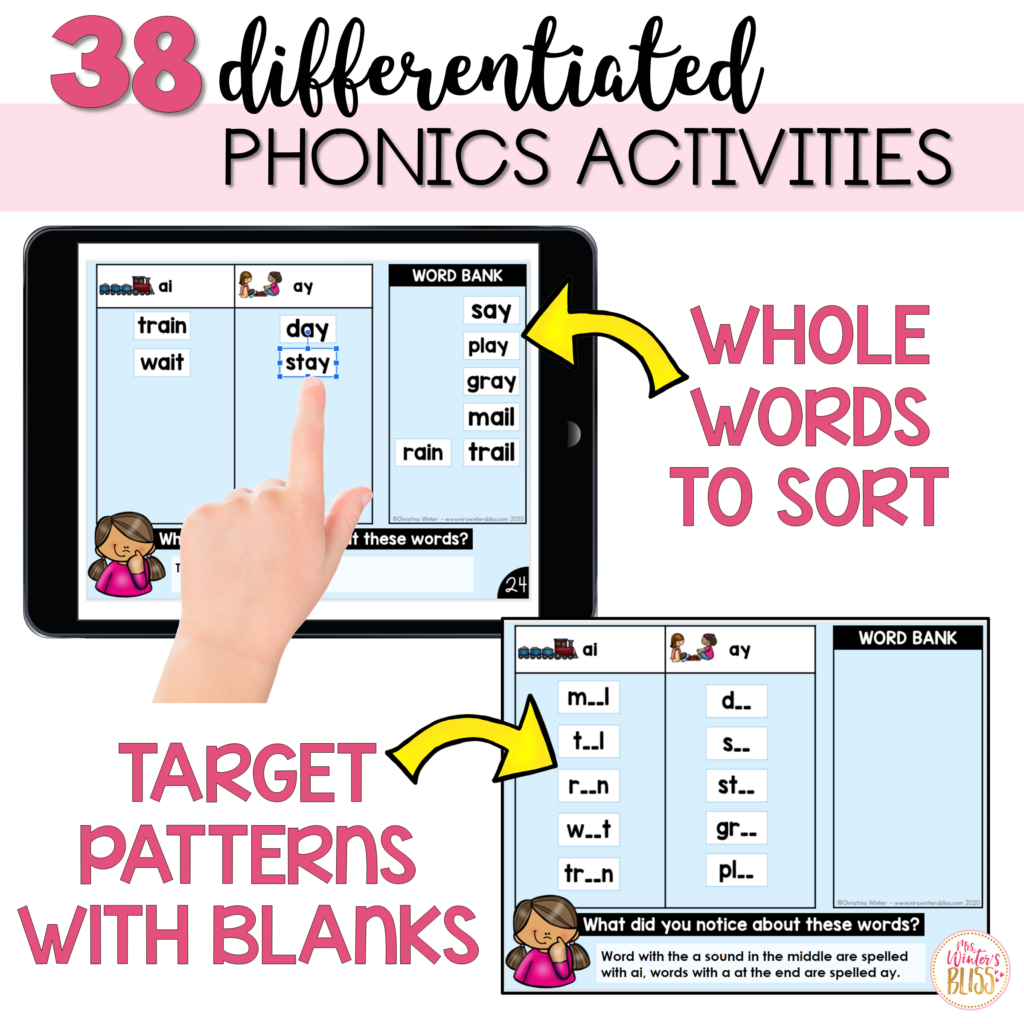
The resource includes the following Phonics Patterns:
- CVC Words
- Digraphs
- Blends
- Long Vowels
- Diphthongs
- R-Controlled Vowels
- Complex Vowels
All activities in the resource are all based on Wiley Blevins’ recommended scope and sequence for K-2 students. You can be confident that they are developmentally appropriate and provide the scaffolding students need for mastery.
Easy to Prep and Manage!
One of the major pitfalls with some word sorts is that they often require a lot of small pieces of paper, letter cuts, or word cards. They can take a long time to prep, distribute, and collect!
But NOT these activities! The printable pieces require very few cuts for students. There will be NO TIME wasted dealing with materials!
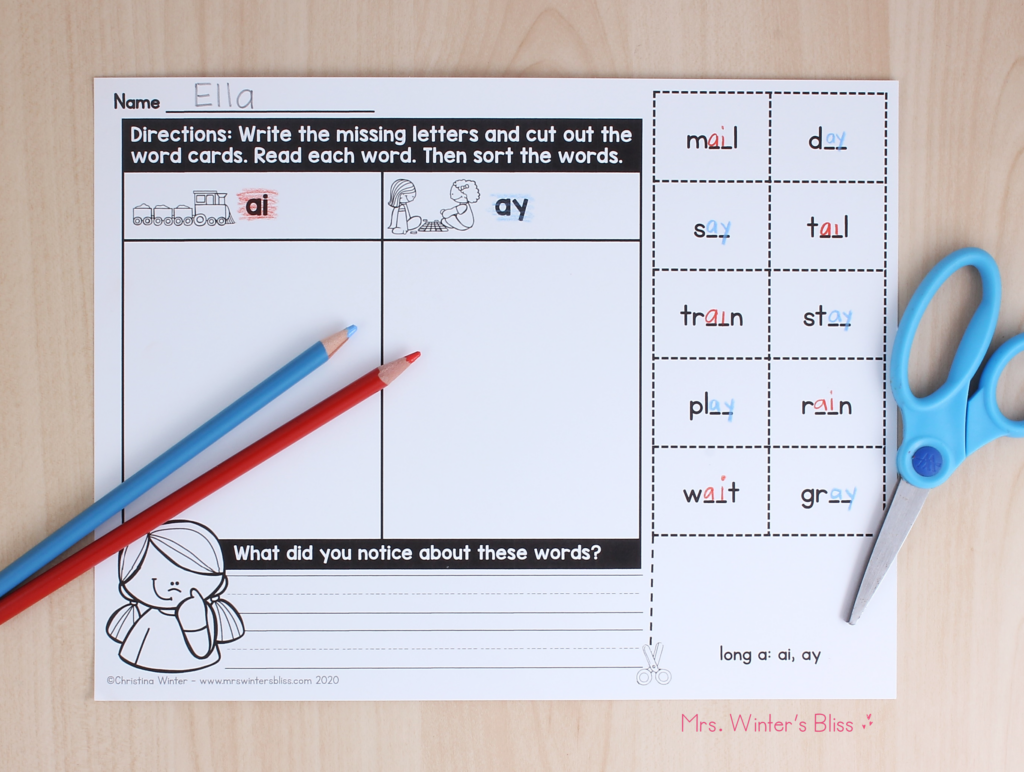
The digital version has been PRELOADED for you. With 1 click you add them to your Seesaw library or Google Drive and then you can assign them to your students for remote learning or individual centers!
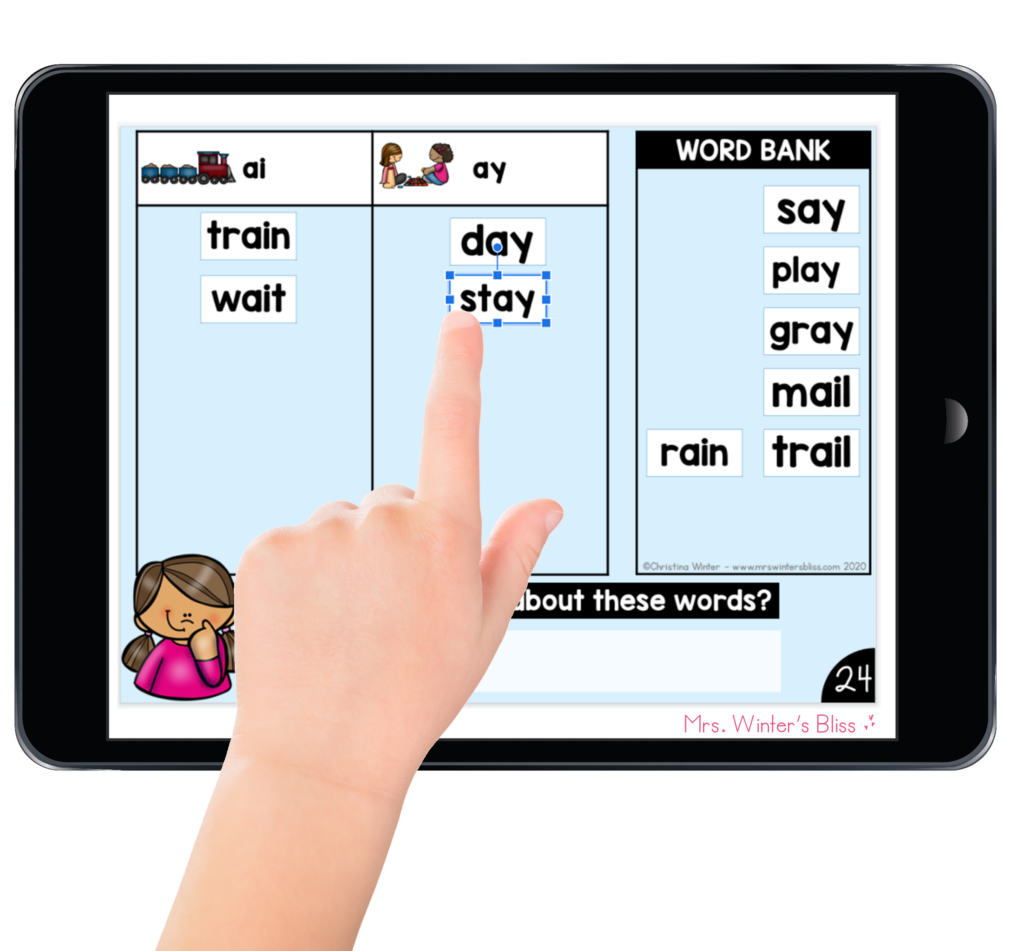
Another BONUS is that the structure of each word sort in the resource remains the same. This saves you from having to explain and model everytime you assign one! Once your students have successfully completed one sort, you can be sure they’ll be able to independently work through the rest at whatever pace you assign them! And with 38 different word sorts you’ll have enough to last you the ENTIRE YEAR!
Download FREE word sorts here:
-
FREE Phonics Word Sorts – DIFFERENTIATED – digital & printable
$0.00
Rated 4.86 out of 5 based on 7 customer ratings
-
Phonics Word Sorts – DIFFERENTIATED – digital & printable
$13.00
Rated 5.00 out of 5 based on 6 customer ratings
I hope the information and the word sorts I’ve shared today will make it easy for you to provide your students with meaningful practice that will allow them to develop their word awareness and master their phonics skills!
Be on the lookout for my next blog post where I’ll be sharing all about another great activity to help develop word awareness- Word Building Activities!
– SHOP THIS BLOG POST –
-
Phonics Word Sorts – DIFFERENTIATED – digital & printable
$13.00
Rated 5.00 out of 5 based on 6 customer ratings
-
Beginning Sounds Alphabet Sort – Google Slides, Seesaw, & worksheets
$8.00
–PIN for LATER–
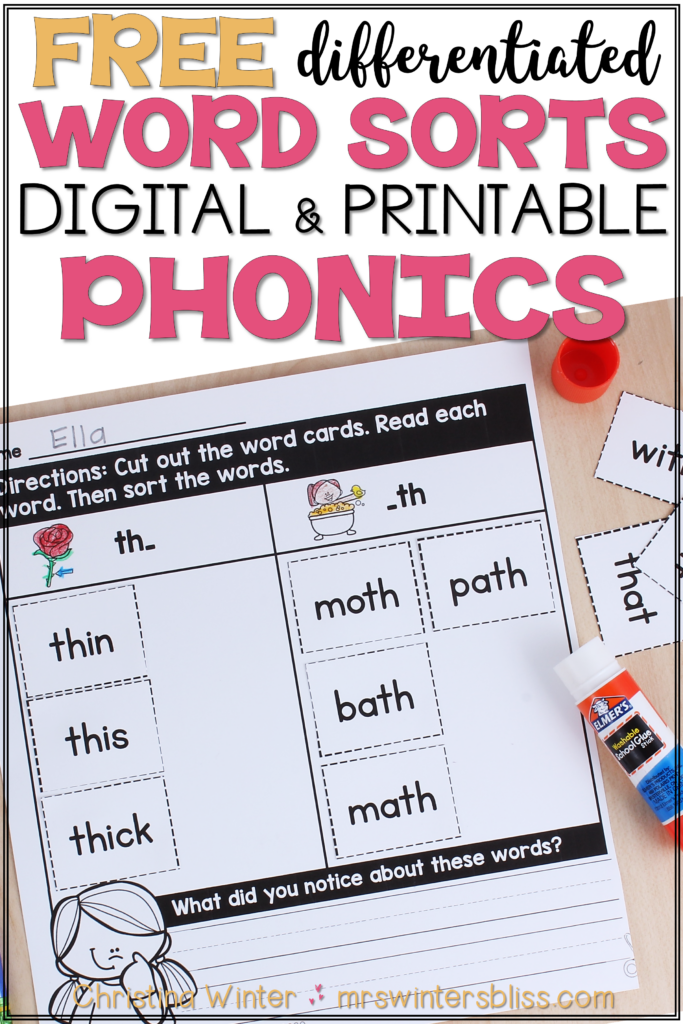
Inside: My 10 favorite word sort activities. Use these in your classroom or for distance learning to build up spelling and phonics skills.
O
n Thursday nights when I was in 2nd grade, my mom turned into a spelling cheerleader.
“B clap, U-R clap, R-I clap -E-D!” she’d chant.
It wasn’t that my mom loved spelling like teachers love a snow day.
But there was a reason she got involved.
I did the typical practice, copy the word a few times, try it from memory, question what in the world is wrong with me when my attempt doesn’t match the narrow paper list… again!
That’s when my mom stepped in with something loud and theatrical to sear the word into my memory (and also to get my perfectionistic butt to bed!)
The question is: why, for a decent reader and writer like me, was it so hard to memorize the words on my spelling list?
The Problem Was This:
In the early 90s the weekly spelling lists were a random collection of words that someone, in some office, somewhere, thought kids needed to know how to spell.
With no rhyme or reason to the word lists, it WAS a tedious effort to memorize those spellings.
But that’s just the way spelling had to be… or was it?
Enter: The word sort


Words in a sort are chosen because they fit in specific categories.
Word sorts work like this:
- Kids learn the sound or rule for each category
- They sort cards with words that each fit into each of the categories
- They practice with the spelling sort in a variety of ways
So the critical question is…
Do Sorting Activities Actually Improve Spelling?
I was excited to learn that researchers find word sort activities improve not only spelling, but also reading skills!
Studies show that students who receive word sort instruction perform better in phonemic segmentation, word identification, and spelling than students who receive traditional spelling instruction.
(Joseph, 2000)
Word sorts help you explicitly teach phonics skills and tap into the power of word families, both research-based strategies for teaching.
You might be thinking: Ok, word sorts improve spelling, but don’t kids get bored with lining up word cards? How do I keep the task fresh so kids stay engaged?
9 Word Sort Activities for Busy Teachers
With simple supplies that you probably already have, you can easily switch up your word study routine to keep it interesting. These tasks work well as part of a daily whole-class word study time, a spelling center, or as homework.
1. Highlight the pattern – When kids notice familiar letter patterns in words, suddenly they go from tediously sounding out “c – a – t” to fluently putting together chunks in bigger words, like “c – au – tion.” Have students use highlighters (and even color-coding) to mark the patterns they find.
Keep in mind: this might be a “sometimes” activity because finding and marking the patterns is beneficial but students could then rely too heavily on color matching instead of pattern recognition when using the word sort repeatedly.
2. Speed Sort – Lots of kids are motivated by competition. Here are my favorite ways to speed sort:
- Students start sorting their words when you say “go.” They stand up when they’re done.
- Students race against a partner to see who can sort faster.
- Students work on their own with a timer and try to improve their time.
3. Sort and Write – Students sort their word cards and then record their work by writing it in a notebook or on a whiteboard.
**Definitely do this one!** Students seem to retain the words much better if they have practiced writing them, not just sorting the pieces.
4. Find My Mistake – Challenge students to solve the puzzle and prove that they can’t be tricked!
- Each student completes their own word sort.
- Then the move a few words into the wrong columns.
- Switch with a partner and see if each student can find the other’s mistakes and fix them.
5. Digital Sort – Take word sorts to Google Classroom, SeeSaw or another digital platform. Set up a background and word boxes yourself or go for a premade set of digital word sorts. This option is great as a word work center in class or as an option for distance learning.
Digital Sorts for Google Classroom
Digital Sorts for Seesaw
6. Sort the Room – Cut apart a word sort and tape the words around the room. Kids write the headings in their notebook. Then they walk around the classroom and write the words in the correct column as they find them.
Worried about finding the time to cut and tape up the words? Make it a special job that a student or two can help out with.
7. Rhyme and Write – Students draw out a card from their word sort. They write the word and see how many other rhyming words they can come up with. This way they are generalizing the spelling pattern to more words.
8. Quiz a Partner – Students work in pairs. Both write the sorting categories on their paper. One partner pulls a word card and reads it. The other partner tries to spell it in the correct column. They check the word together. Then they switch roles and continue.
9. Use in a Sentence – To push students to the next level of understanding, challenge them to use words from their sort in the context of a sentence.
10. Sort and Glue – Save this one for the last time you want to use each word sort. Kids sort out their word cards and then glue them down either in a notebook or on a piece of paper. The glued sort can be used later for reference during writing and for review.
A Simple Routine for the Win
One of the worst mistakes I made as a new teacher was thinking that kids could be exposed to a skill once and be good to go! Wouldn’t that be nice? That would be like if I could follow my phone’s navigation to get somewhere once and never need to look that place up again….pshh :::shades face with hand:::
Kids need to practice with the same sort a few times.
You don’t want them to get bored with it but you also don’t want to exhaust yourself by reinventing the spelling practice wheel every day or week.
There’s a simple solution: Set up a weekly rotation of word sort activities from the choices above. After a few weeks, change out one of the activities for something new. Repeat all year!
It might look like this:
- Monday – Introduce the spelling sort, kids all sort once
- Tuesday – speed sort
- Wednesday – sort and write
- Thursday – sort and glue
- Friday – spelling test on the sort words
Looking for More Support with Word Sorts?
- Research About Spelling for More Effective Instruction
Printable word sorts
Word Sorts for Google Classroom
Word sorts for Seesaw
References:
Joseph, L. (2000). Developing first graders’ phonemic awareness, word identification and spelling: a comparison of two contemporary phonic instructional approaches. Reading Research and Instruction, 39(2), 160-9.
Hannah Braun is a former teacher with 8 years of experience in the classroom and a master’s degree in early childhood education. She designs engaging, organized classroom resources for 1st-3rd grade teachers.





